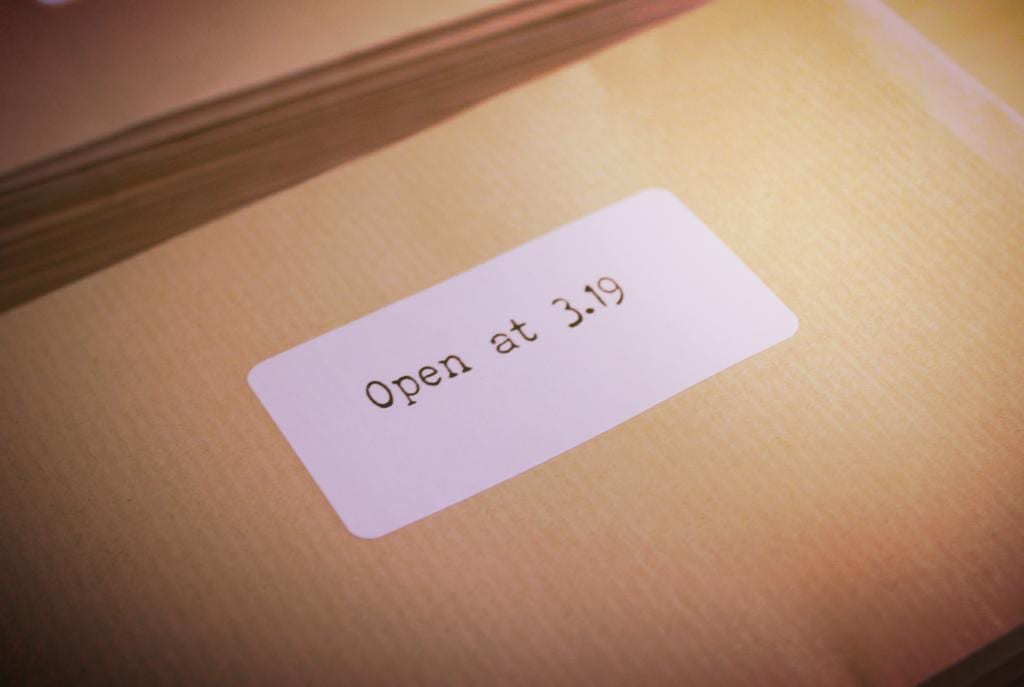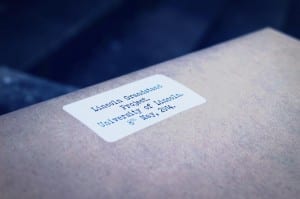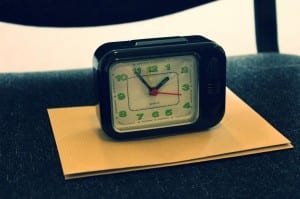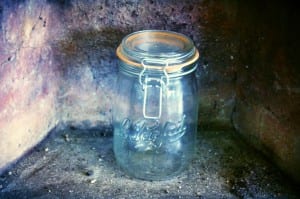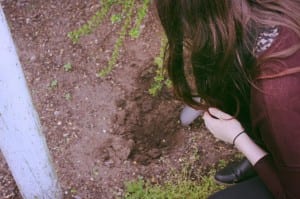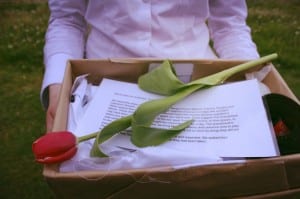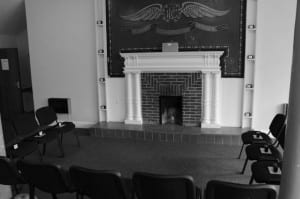“This process of making strange enables the artist to relate to the site in a way that may educate, inspire and politicise an audience” (Govan, 2007, 122).
The Waiting Room focuses on the passing of time and makes strange the idea of waiting. The site specific work created and performed at Lincoln Grandstand takes into consideration the many jobs that it has had and it’s place within the Lincoln community. With the help of public research the Grandstand becomes a time capsule of the last decade as we stop and look at what has happened with specific reference to one room within the building.
The Waiting Room is a performance that relies heavily on the co-operation of an active audience. The work “creates a sense of communion” (Govan, 2007, 114) between the actors and the spectators as the audience are seated with the actor and are a vital part of the performance. Inspiration is taken from practitioners and theatre companies such as Rotazaza and their work Etiquette and also the work on LIGNA and their Radio Ballet. Both of these pieces of work have a dependency on the audience/participants and encourage the use of audience participation in situations that audiences are very much familiar with. In The Waiting Room the use of audience participation is exploited as they are given envelopes as a way of instructing them what to do.
As previously stated, The Waiting Room focuses on the passing of time and how reliant we are as a culture on it. It also portrays how reliant the Grandstand is on time and how it has for many years now been waiting for something new. The passing of time has seen the Grandstand go from a thriving establishment to a place that no one of the younger generations has any knowledge of and our site specific work addresses these issues.
The Waiting Room takes the history of the Grandstand and ideas about waiting and structures them into a performance piece performed by the audience. The Waiting Room is a fifteen minute performance which is designed to accommodate up to eight participants at a time. Post performance a time capsule is collected with tokens from each performance that happened that day and then it is buried at the site. This symbolises the stopping of time which happens after each performance when the audience are asked to take the batteries out of their clocks and then leave the site. This is recorded and presented at a later date for those who could not witness the burial. The Waiting Room hopes to “educate, inspire and politicise” (Govan, 2007, 122) its audience and help them focus on the decaying effect that time has on everything.
We had been interested at first in many aspects of the Grandstand. We really loved the corridor at the back of the Grandstand which led to the toilets. We thought that the contrast of the old tiles and windows on one side to the newer windows on the other was beautiful. During the first week we developed a short piece of work here which also if developed more would have told the stories of the local community and their memories of the Grandstand. We were also drawn to a room that was off of this corridor. We were intrigued by the painting on the wall and wanted to know more about its origins. This is why for us visiting the archives was a break through point.
We explored the archives, asking questions about what the Grandstand could have been used for. We noticed that the room we were interested in might have been used as a waiting room as there were plans to use the Grandstand as a mortuary during World War Two. Whether it was or not cannot be confirmed and all we found out is that this may have been a possibility.
As you can see on this picture of the plans we found at the Lincoln Archives, there is one room that is labelled office and waiting room. This is the room that we were first intrigued by. At an early stage in our process, we knew that the room was used for waiting in and we liked this idea of people waiting for something as the Grandstand has been waiting for years now.
We continued to explore what the Grandstand had been used for over the past few decades. We also knew that the Grandstand was used to test planes and to train pilots during WWII. This introduced another element of waiting. We started to see links between the Grandstand and waiting and wanted to research this further.
We also thought it was important to investigate other reasons for waiting. We thought the best way of doing this was through an online public survey in which we asked the public what they were waiting for and also what they thought the Grandstand was waiting for. We also went into the town centre of Lincoln and asked the general public the same questions. The idea of using public research in performance was inspired by John Newling’s work, Where A Places Becomes A Site. This work took place in Broadmarsh shopping centre in Nottingham, where a riddler jacket was hung from the ceiling and trailed along the floor. The audience were asked what they valued most and in return Newling gave them a question mark cut out from the jacket which was then pinned to their clothing. These values were then compiled into a script ready for live performance. This audience involvement makes the performance more relevant to the site. Newling asked people what they valued most in a place of material worth and by asking the people who frequent the location this makes the performance raw and unique.
(Nottingham Contemporary, 2013)
Newling’s performance was very much based on the public survey whereas we wanted to integrate this into our performance. The results from the survey gave us many varied answers. Later on in the devising process we decided that we wanted to combine the results from the survey and interviews into the narratives that would be performed by the audience members.
Here are some of the results…
What are you waiting for?
Waiting for a wedding.
Waiting to become a teacher.
Waiting for pay day.
Waiting for my dinner to go down so I can eat my Crunchie.
Waiting for a less stressful day at work.
Waiting to finish university, get married and have a family.
Waiting for summer.
Waiting to do a 12 hour lambing shift.
Waiting for the next chapter.
Waiting for happiness.
Waiting for my future to begin.
Waiting for my house to be built.
Waiting for my wife.
Waiting to be old enough to join the army.
What is the Grandstand waiting for?
A bulldozer.
Something new.
To be used again, like when the horse racing was there.
A new lease of life.
A grand event.
To be decorated.
A facelift.
A race.
A comeback.
To be noticed.

Rotazaza (2007) Etiquette [image online] Avaliable at http://www.pq.cz/en/rotozaza-etiquette.html [Accessed 3rd of March 2014.]
Another performance where the audience were controlled using instructions is Ligna’s Radio Ballet (2003). This performance consisted of audience members turning up to a location wearing headphones that were tuned to a certain radio station. Instructions were then given over the radio and the audience members completed the movements. This once again takes audience participation to a new level. The audience become the performers rather than an audience in the most basic form. The location for the Radio Ballet is usually a train station where “the system of control is designed to keep out every kind of deviant behaviour” (Ligna, 2003) and anyone behaving out of the ordinary is “detected immediately and instantly expelled” (Ligna, 2003). Therefore performing the Radio Ballet is a response to the site and how people are expected to behave in a strict manner without the chance for individuality and self-expression.
(Radiodispersion, 2008)
We were inspired by how the audience were instructed in both pieces and we also liked the idea of the audience wearing headphones. However, after doing some technical research we found that this would only be possible if we had an audience of two people. We wanted to have a bigger audience than this and this is when we decided on using the envelopes as the way of instructing. We also decided that we loved the simplicity of it. Instead of relying on technology we could create a performance by using the most basic form of communication- letters. This also meant that the audience were reliant on the time rather than having the information just given to them. As we wanted to focus on the passing of time, the use of envelopes was more effective. Nevertheless, both of these performances helped us to understand how we would control the audience.
We wanted to put an emphasis on the passing of time and how when you are waiting, time seems to pass at a slower pace. Therefore, we decided on putting times on the envelopes for when the participants should open them. We also did this by giving everyone a small clock so that they could be constantly watching the time. We liked the idea that everyone was waiting for the time to pass so that they could have a purpose. This was a key link to the Grandstand for us. After doing our audience research we found that many people thought that the Grandstand needed a purpose and was waiting to have a better purpose than for people to play carpet bowls in and for children’s play groups.
When developing our work, at first we decided that we wanted to have dialogue performed by us and this would be our purpose within the performance. However, after hearing feedback and group discussions, we decided that it would be best for the audience to speak the dialogue as it had a nicer effect than for us to speak it.
Examples of the narration written by me.
However, when we decided this, we encountered a dilemma as this meant that we would not be doing anything. This is when we decided that we would be introducing moments of intimacy between ourselves and audience members. These would be as simple as laying our heads on the shoulders of those next to us or holding their hand. This intimacy was inspired by Oreet Ashery’s one to one piece Say Cheese (2002) during which she dressed as a man and lay on a bed with the participant and spoke with them. This location first of all is very intimate but she made the situation more intimate by creating a therapy like session during which the audience members could confess to her.
Another performance where this intimacy is conveyed is Adrian Howell’s The Pleasure of Being: Washing, Feeding, Holding (2011) during which he bathed, fed and comforted one participant over half an hour. This performance holds a lot more intimacy than we wanted to include in our performance but the idea of comforting the participants and in some cases making them feel awkward in the situation is something we wanted to achieve.
In Emma Govan’s chapter Inhabited Spaces she explores the work of the Reckless Sleepers in their piece Last Supper (2005). She stated that the sense of “evoking the invisible” (2007, 115) that the company creates through giving “voice to the voiceless” (2007, 115) is increased through the “directors encouragement of non-performing” (2007, 115). This was achieved through the use of the “reportage style” (Govan, 2007, 115) and the lack of emotions used within the performance. Another technique that they used to portray ‘non-performing’ is reading from the script. This is something we adopted into our performance as well as the lack of emotions. At the end of our performance, Samantha read the list of reasons for waiting from a script that she had typed during the performance. This was something that became unique to each performance as the list changed and altered slightly each time it was written. This sense of originality in the text as well her reading it from the paper showed non-performing. Also, throughout the rehearsals process and performance we always tried to be someone other than ourselves. This is the main portrayal of non-performing within our performance.
In Govan’s chapter she also states that “for a moment the spectators from the outside join a living moment with the actor who inhabit the inside space of the performance environment” (2007, 114). This is also something that we could apply when looking at The Waiting Room as we did create “a ‘lived-in’ space” (Govan, 2007, 114) as the piece raised issue of how the space was used. The performance combined the “present and past, and inside and outside” (Govan, 2007, 114). The audience left knowing more about the Grandstand and in particular the room we used.
Throughout the devising of our work we had toyed with the idea of creating an installation with the letters, airplanes and clocks that would be used within the performances. As we wanted to do several performances with gaps in between to reset the area we thought this time could also be spent building an installation. This meant that in every performance the installation would look different. After the performances had finished we would have had an allotted time in which people could look at and explore the installation. When looking at how we could structure the installation, we looked at work that was built using mainly paper. We discovered one piece of work that was constructed using paper airplanes.

Ng, D. (2009) ‘Dawn Ng’ [image online] Available at http://www.dawn-ng.come/new/paperplanes/4.html [Accessed 3 May 2014].
We then started to think what we had done at the Grandstand through the previous weeks. Near the beginning of the process, we were asked to take a gift to the Grandstand and we really liked the idea of leaving part of what we had created at the site. I then suggested that we bury a time capsule containing elements of our show and this process would also be documented.
We all agreed that this idea was one that we very much liked and decided to move forward with it. After a little more discussion, we decided that we would ask the other groups to add something into the capsule so it will be a collection of all of the performances took take place on the 8th of May 2014. We also decided that at the end of each performance we will ask the audience to take the batteries out of the individual clocks and place them in a jar. This image of stopping time and then burying it at the site is one that we thought was very fitting with our piece. Asking the audience to take out the batteries would be done using the poem ‘Stop The Clocks’ by W.H.Auden. We had wanted to use this poem since quite early in the process due to its links with our performance. The poem seemed to claim a worthy spot at the end of the performance as the audience left the site having stopped the clocks.
On the 8th of May 2014, four performances of The Waiting Room took place and each one of them was different. We quickly found that the number of audience members really had an impact on the performance. The first performance had seven participants, the second had five, the third had two and the fourth had eight. Although all of the performances were successful we found that the ones which had more participants were more engaging as we did not have to take the places of the audience members. However, all audience members were co-operative and helped us to create work that was exciting and engaging.
Some audience members told us that they really enjoyed the piece and felt like the time, when they were taking part, passed slowly as they were constantly watching the clocks. One moment that was very effective is when one participant was asked to laugh hysterically and he did so proudly. Another participant was then asked to speak and because the laughter was still occurring, the second participant had to shout over it. The juxtaposition of the serious text and the laughter was something that in rehearsal we had never encountered and this is what made each performance special. The different participants each bought something to the performance. Some were uncomfortable when speaking so were quieter and spoke very differently to those who were more confident. No one person spoke the text or performed the actions in the same way and I think this is something we had underestimated but it really meant that each performance was unique. A weaker part was during the second time we performed when Samuel laughed at people that were in the audience. Although we did adopt the ideas of ‘non-performing’ there still needed to be an element of professionalism within the performance and I felt like the laughing broke this.
Here is the video of the burial of the time capsule which took part after all of the performances were complete.
(Alicedalemusic, 2014)
If we were to perform The Waiting Room again, I would ensure that we had five or more participants at all times. Although we had backup plans for any number of participants, as I said previously the ones with the most people were the more effective. I would also attempt to push more boundaries when it came to making the audience feel uncomfortable. I think we could have definitely made this part of the performance more experimental and really made them feel awkward in the room. After the process I feel like I have a better understanding of what site specific performance is and if I was to redo the process now it would result in a more experimental piece. However, I do believe that The Waiting Room showed a clear understanding of the Grandstand and was definitely relevant to the site. Our performance was influenced by the Grandstand and the history that has lived within its walls for the past century.
Performance pictures…
Word Count- 3,201
References-
Alicedalemusic (2014) ‘The Waiting Room’ Time Capsule (Post Performance) [online video] Available from https://www.youtube.com/watch?v=qHRYiH8IqM8 [Accessed 10 May 2014].
Govan, E., Nicholson, H. and Normington, K. (2007) Making a Performance. London and New York: Routledge.
Ligna (2003) Exercise in lingering not according to the rules [online] Available athttp://ligna.blogspot.co.uk/2009/12/radio-ballet.html [Accessed 10 May 2014].
Ng, D. (2009) Dawn Ng. [online] Available at http://www.dawn-ng.com/new/paperplanes/4.html [Accessed 03 May 2014].
Nottingham Contemporary (2013) John Newling Where a Place becomes a site: Values- Participatory Performance. [online video] Avaliable from https://www.youtube.com/watch?v=SxJC12KqZsQ [Accessed 05 May 2014].
Radiodispersion (2008) Radio Ballet Leipzig Main station Part 1 [online video] Available from http://www.youtube.com/watch?v=qI3pfa5QNZI [Accessed 11 May 2014].
Rotazaza (2007) Etiquette. [online] Avaliable from http://www.pq.cz/en/rotozaza-etiquette.html [Accessed 13th May 2014].


